If you need to get multiple records into Infoplus (e.g. multiple Orders, multiple Items), put the data into an Excel or .csv file and then upload the file into Infoplus using the Bulk Load process.
The Bulk Load process is available in select Tables (e.g. Orders, Items, Customers, ASNs, and more).
Important Note: Only bulk load in batches of 5,000 or less except for Orders. You can only bulk upload 1,000 Orders at one time.
- Best practice is to perform large bulk edits and/or loads outside of peak business hours
For a step-by-step demonstration of bulk loading records into Infoplus, see the Video: Bulk Load Records.
The source file must contain required information in order to be uploaded. A list of required columns, as well as a downloadable template contain required column headers, are available after you select the Bulk Load action in the particular Table. For information on creating the bulk load source file, see Create a Bulk Load Source File.
NOTE: The steps below provide universal instructions for bulk loading data into Infoplus; however, screenshots are from an Order Bulk Load. All bulk loads work the same, but for an overview and a list of required fields for specific types of bulk loads, see the list of related bulk loads at the bottom of the page.
Bulk Load Records into Infoplus
- Access the Table you want to bulk load data into.
- One method to access a table: Press the dot (period) on your keyboard, and select the table from the list of Quick Actions (i.e., Order, Item). - From the Actions drop-down menu, select Bulk Load. Steps in the Bulk Load process appear in the top right with the Options step selected.
Options will differ based on the type of upload you are performing:
When bulk loading Orders, the “Options” step is where you select whether you are uploading a "Wide Format" or "Tall Format" source file.
- Wide Format source file: There is one row per order. One row could contain multiple line items (SKUs) for the order. In order to upload this file, a row (order) cannot contain more than 25 SKUs.
- Tall Format source file: There are multiple rows per order. Each row contains one line item (SKU). This format allows you to upload an unlimited number of SKUs per order.
When Bulk Loading Items or ASNs, the "Options" step is where you select your LOB (Line of Business).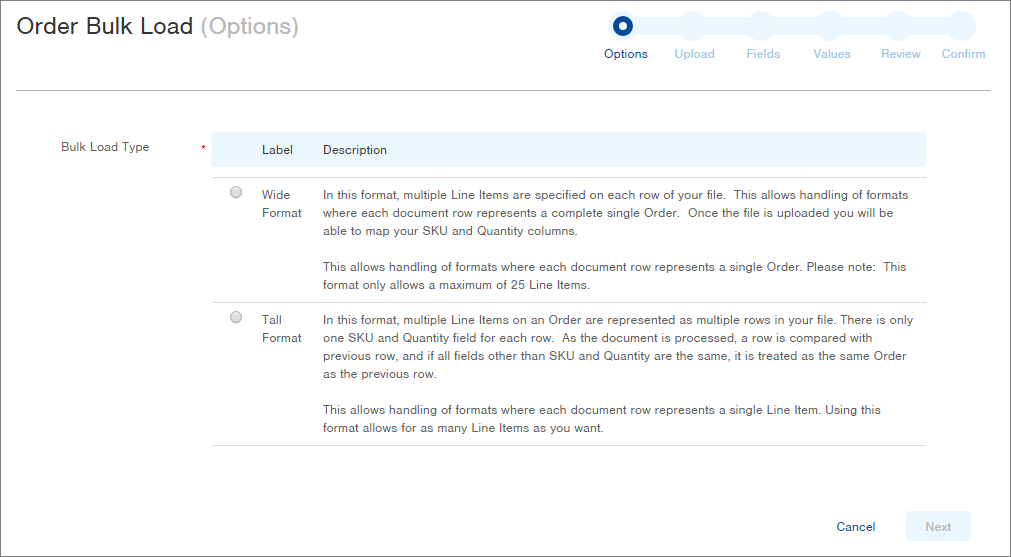
- Once you have selected Options (if necessary), click Next. The Upload step in the process appears.
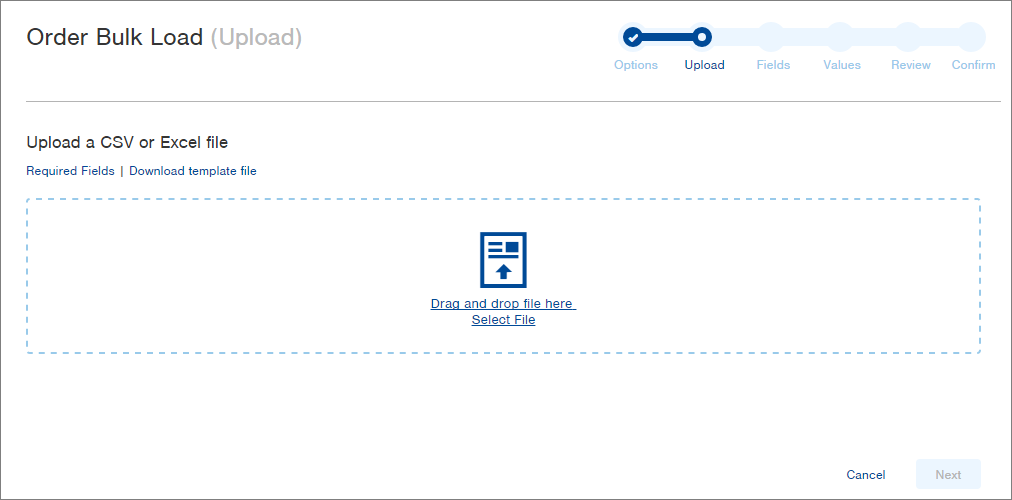
- Either drag and drop the file to be uploaded onto the icon, or click the document icon to select a file on your computer.
NOTE: To view a list of the fields required for upload, click the Required Fields link in the top left. To download a template file containing required field headers, click the Download template file link in the top left. If you would like help on creating your bulk load file, see Create a Bulk Load Source File. - After loading the file, click Next. The Fields step in the process appears. The fields will differ based on the Table you are uploading data into, but the screen functionality and steps below are the same for all bulk loads.
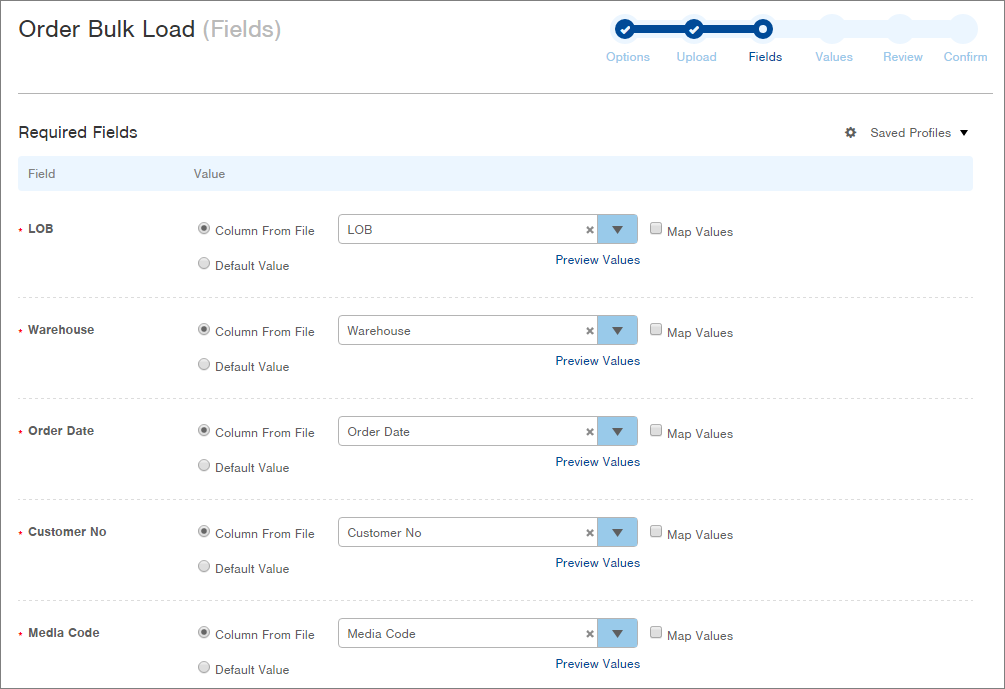
NOTE: If you saved a profile, which saves your Fields and Values selections, click the Saved Profiles drop-down menu and select the Saved Profile.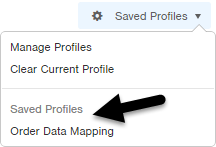
If you have not saved a profile and would like to save the mapping you are currently developing, you will have a chance to do so in upcoming steps. - Make your selections for each Required Field (Column From File or Default Value).
- Select Column From File to upload values from your source file. Select the source file column from the drop-down menu. Use the "Preview Values" link to see a sample of your source file's values.
NOTE: When uploading values from your source file, consider the Map Values checkbox. By selecting this checkbox, after you click Next, you will be able to map values in your source file that may not be recognized by Infoplus (e.g. map the value your source file uses for the UPS Ground carrier to the value Infoplus uses to represent UPS Ground).
- Select Default Value if you want to select/enter a default value for each record in your source file. Once selected, a blank field will appear for you to enter or select the Default Value. The Default Value will override any existing data in your source file, if there is any. -
If you want to add fields to your mapping (beyond the Required Fields), click the Add Optional Field button at the bottom of the window.
NOTE: Some fields may already be added to this section.
Once you click the "Add Optional Field" button, a popup will appear for you to select the Infoplus field you want to map. For example, if your source file for Orders contains "Carrier" information, even though that Field is not required to upload the data, you can add it as a field to be uploaded at the bottom of the window. Here's an example of the Carrier field already added to the screen (and mapping already applied):
NOTE: The "Map Values" checkbox is selected in the above screenshot. After clicking Next, you will be prompted to match each value from your source file to an Infoplus value. -
After making your mapping selections, click Next. If you had selected the "Map Values" checkbox for any fields on the previous screen, a Values screen will appear for each checkbox selected. From the drop-down menu(s), select the appropriate Infoplus value for each source file value. For example, here is the Values screen for the Carrier field where the source file contains values that Infoplus won't recognize:
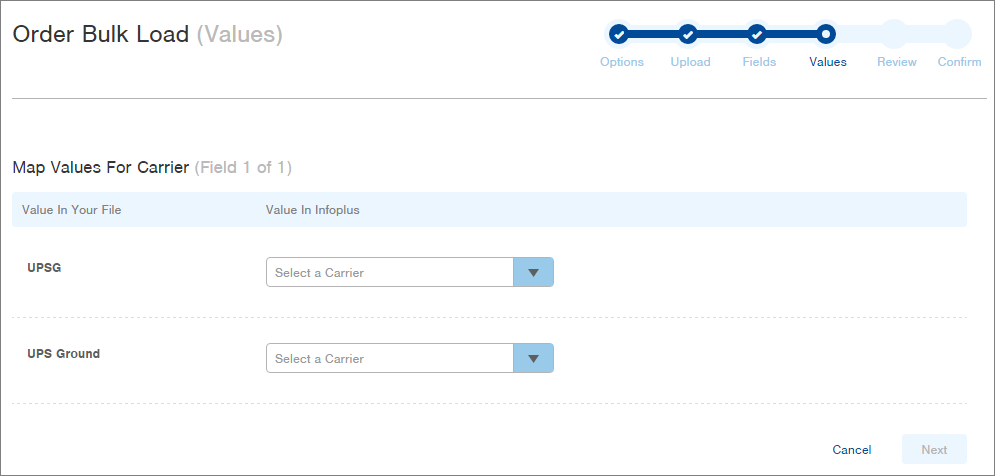
Here's an example of completed value-mapping for the Carrier field: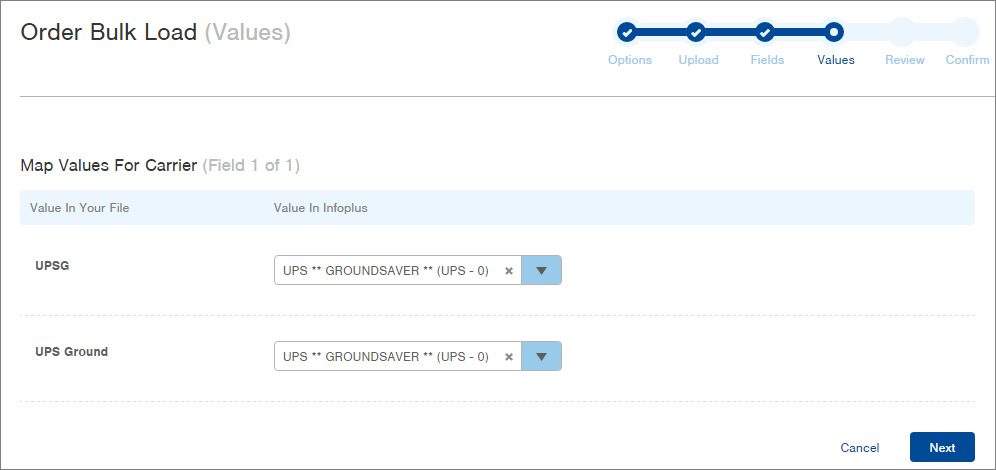
-
After making selections in the Values screen (if required), click Next. The Review screen will appear.
NOTE: Click the Actions drop-down menu to export these results to Excel. If errors were found, the exported file can be helpful as a reference when fixing errors. Also, a Back button appears at the bottom of the window which will take you back to a previous step in the process if you can fix an error that way.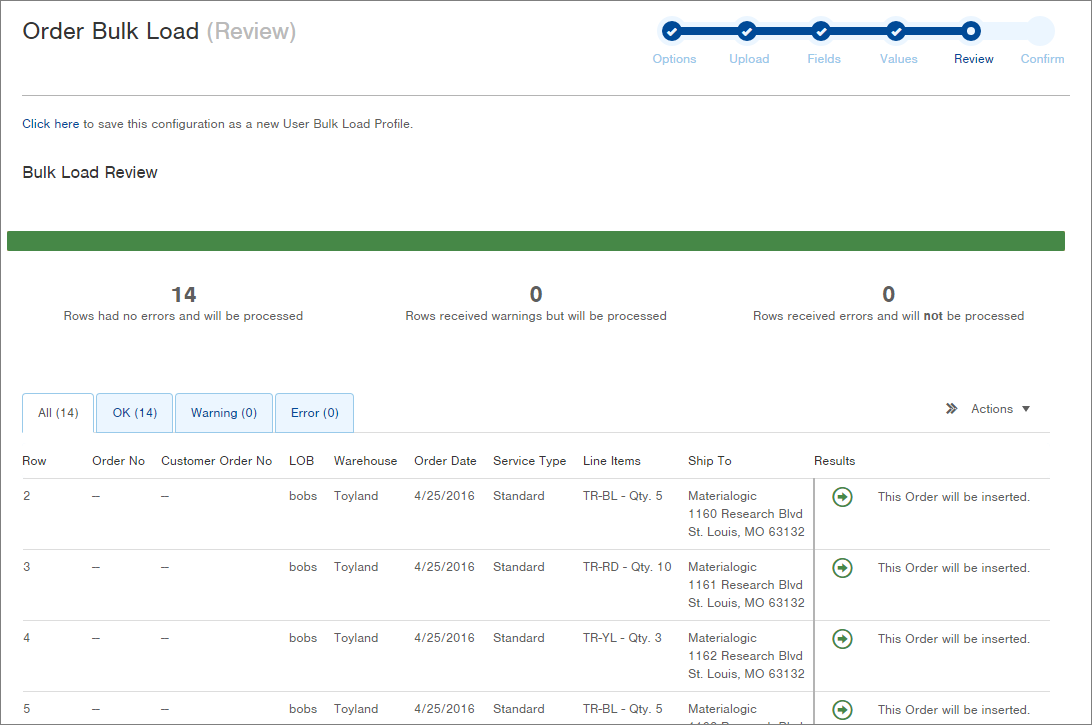
NOTE: In the example above, all records were OK, so the results indicate that the records will be inserted. Common error messages include "record already exists" which means the upload contains the same record as previously uploaded (e.g. the same Item) or "Unknown value" which occurs when Infoplus can't read a value (e.g. if you didn't map the Carrier value of UPSG to a Carrier value in Infoplus). Some errors may require you to edit your source file, but many can be fixed with proper mapping selections. If you can fix errors by editing the mapping, click the Back button at the bottom of the window. -
If you would like to save your mapping selections to be used on a future mapping of records to this Table, click the Click Here link at the top of the Review window.

The Save As screen appears: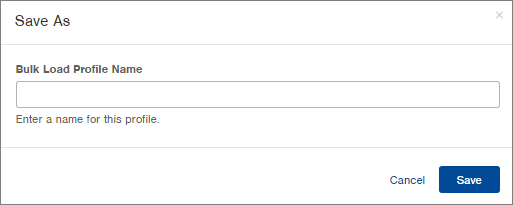
Enter a name for the Profile (i.e., Order Upload) and click Save. The next time you perform an upload and you want to use similar mapping, you can select the Profile during the Fields step of the process.
NOTE: You can still make mapping edits after selecting the profile, and you will have an opportunity to save your changes in the Review screen. -
To perform the upload, click Submit. The Confirmation screen will appear with the final results.

- The upload is complete. You can return to the Table or elsewhere in Infoplus.
NOTE: Click the Actions drop-down menu to export these results to Excel.
- When working through the Bulk Load steps from Upload through Fields, clicking the browser's Back button will take you out of the Bulk Load and return you to the table. The only step that provides a Back button is the Review step.
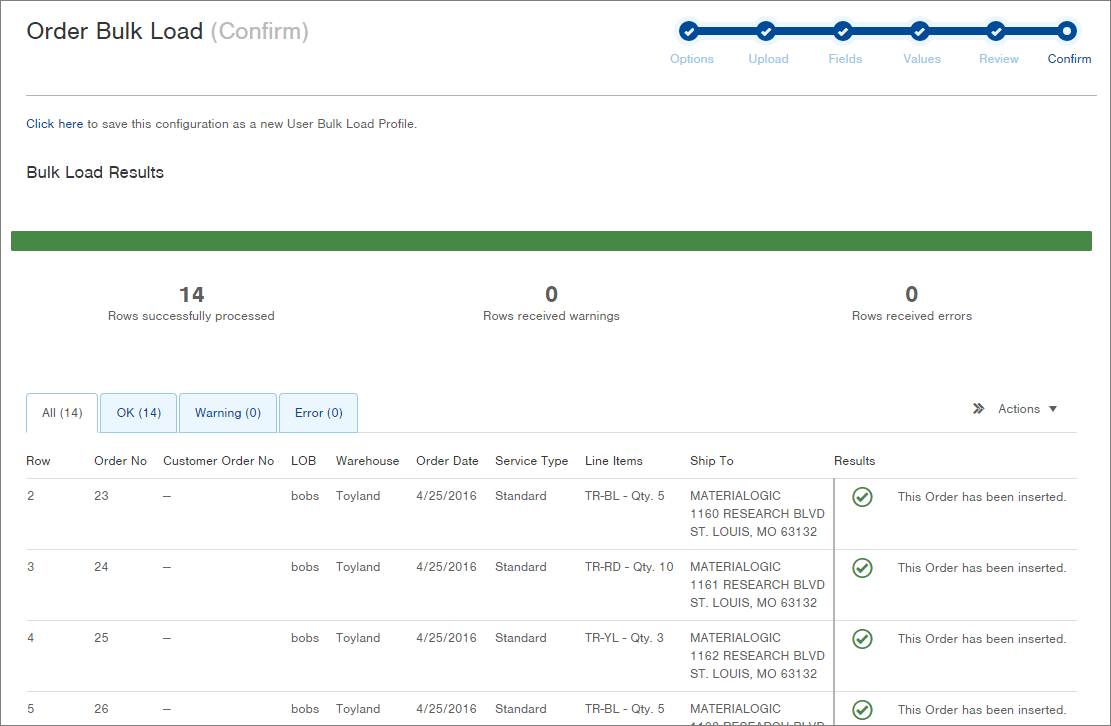 NOTE: Click the Actions drop-down menu to export these results to Excel.
NOTE: Click the Actions drop-down menu to export these results to Excel.
-1.png?height=120&name=InfoPlus-Primary-Logo%20(1)-1.png)